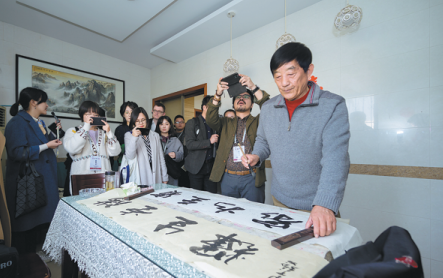Lingtang village excels as a model of rural success
Lingtang in Gaoyou city, Jiangsu province, is not what you call a typical village.
Covering 53.9 square kilometers and with a population of 23,000 people, Lingtang has been the beneficiary of years of government policies aimed at better utilizing the village's natural resources and improving living standards.
As a result, visitors to Lingtang are surprised by what they see-a public square, cinema, sports center, wide streets and well-decorated modern houses.
The village is home to more than 100 companies so there is no shortage of work in industries such as agriculture, tourism, lighting and cable manufacturing.
In 2018, Lingtang's GDP reached 4.28 billion yuan ($612 million). The average annual income for farmers in the village was 33,500 yuan per person last year, data from the local government showed, which was more than double the national average.
Part of the reason for the village's development is that they are good at making use of local resources.
Thirty-year-old company in the village, Wangxianji, has expanded its production base to 2 sq km to include areas for breeding crabs, crawfish and freshwater fish.
Wangxianji's processing plant makes products such as pickled crab, shrimp powder and shrimp roe. Its sales have expanded from being purely offline to online via e-commerce platforms such as Tmall and JD. In 2018, the company's online sales reached 18 million yuan, and reached some 60 cities nationwide.
"As China promotes rural revitalization, more support has been given to agricultural development," Wang told local media outlet Gaoyou Today, adding the city government has supported the hairy crab industry at Gaoyou Lake and invited experts to teach advanced business operating techniques.
Wangxianji has contributed to improving the lives of some 300 local families it employs. Their total income increased 4.5 million yuan from 2017 to 2018. The company also employs extra workers during the peak season.
Several miles away from Lingtang is Wangyao village. Lu Yongdong, director of the village, said the annual economy of the village is worth about 820,000 yuan, with some 600,000 yuan generated from a 1.3-sq-km lake. Per capita disposable income reached 29,000 yuan per year in 2018.
Most residents make their living from fishing, leasing farmland or industrial properties, as well as working for cable or lighting companies.
"There are plenty of jobs. Workers from other provinces like Anhui and Henan travel here during the peak season," Lu added.
Living standards have improved in local villages.
Yang Yunlong, 78, from the Hui ethnic group, and his family live in a two-storey, 200-square-meter house with six rooms and modern appliances in Lingtang. They moved to the village in 2015.
"Before the reform and opening-up, the family lived from farming and life was kind of difficult," Yang said. "Now the living conditions have largely improved."
Thirty percent of the population of Lingtang are from the Hui ethnic group and it has been named a "model village of national unity" by the State Council four times.
Omura Kenichi, a media representative from the Mainichi newspaper in Japan, said he could see that people in the village live a simple, modern and happy life. "In Japan, rural people don't often have such big houses," he said.
Djamshid Mutalov, from Dunyo Information Agency in Uzbekistan, told local media that the Chinese government is providing solid support for ethnic groups to make a fortune. "Here, people from different groups are united. It can be seen that their sense of happiness comes from the heart."

An elderly resident of Lingtang village demonstrates traditional Chinese calligraphy. CHINA DAILY








